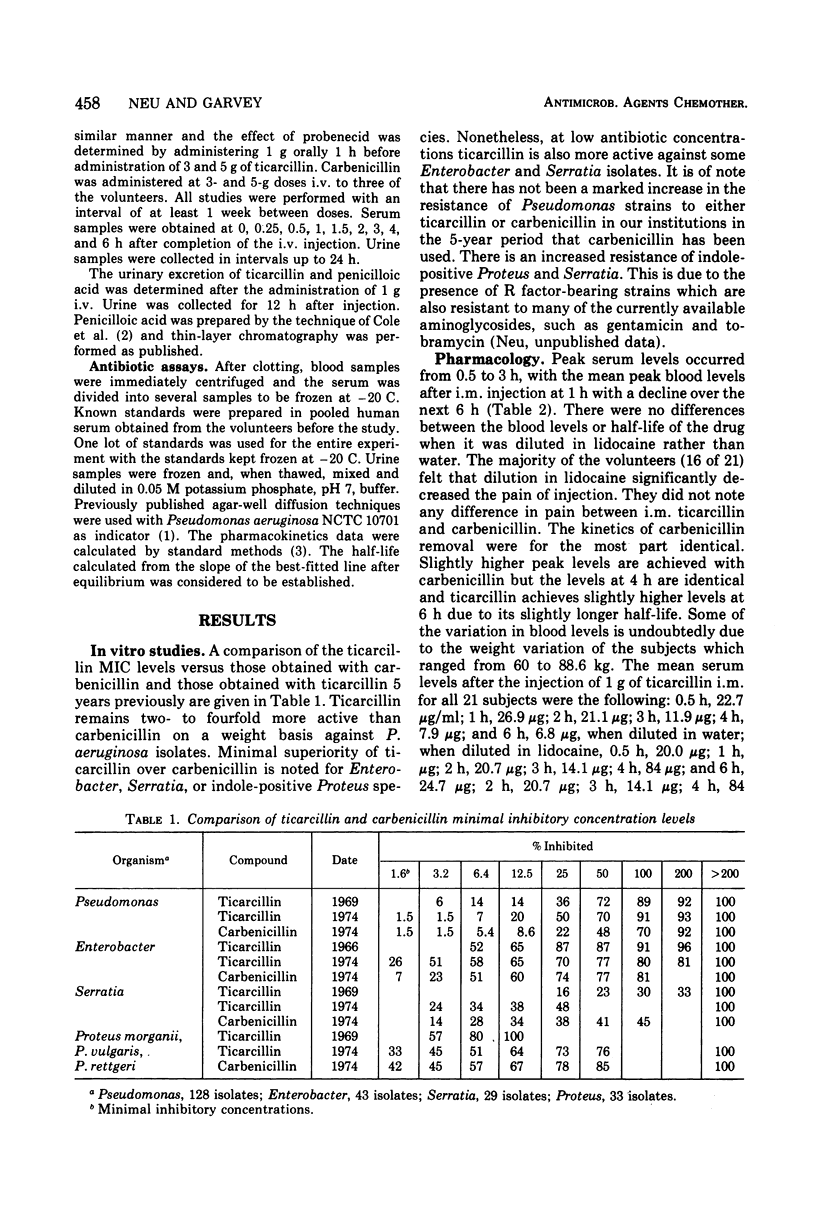Abstract
The in vitro activity and human pharmacology of ticarcillin, a semisynthetic penicillin more active than carbenicillin against Pseudomonas, were compared. There has been no increase in resistance to ticarcillin of Pseudomonas strains over the past 5 years, but resistance of indole-positive Proteus and Serratia strains has been documented. After intramuscular (i.m.) injection of 1 g of ticarcillin, mean peak levels occurred at 1 h (26.9 μg/ml) with a decline over 6 h (6.8 μg/ml). Serum half-life was 84 min. Dilution of ticarcillin lidocaine reduced pain on i.m. injection but did not alter serum levels. Blood levels after 1 g i.m. are adequate to treat infections produced by Escherichia coli, Proteus mirabilis, and some Enterobacter, but not Pseudomonas. After rapid intravenous infusion of 3 and 5 g, mean peak serum levels of ticarcillin were slightly lower for 1 h than those achieved with carbenicillin. Probenecid administered before infusion produced increases in blood levels, half-lives, and volume of distribution. The biological half-life of ticarcillin was 72 min compared to 66 min with carbenicillin. There was a larger volume of distribution for ticarcillin than carbenicillin (15 liters versus 14 liters). The ticarcillin half-life when administered with probenecid was 108 min. Urinary recovery of ticarcillin was 77% against 95% of carbenicillin. However, approximately 10% of ticarcillin is recovered as penicilloic acid so that 95% of an intravenously administered dose is recovered.
Full text
PDF





Selected References
These references are in PubMed. This may not be the complete list of references from this article.
- Burnett J., Sutherland R. Procedures for the assay of carbenicillin in body fluids. Appl Microbiol. 1970 Feb;19(2):264–267. doi: 10.1128/am.19.2.264-267.1970. [DOI] [PMC free article] [PubMed] [Google Scholar]
- Cole M., Kenig M. D., Hewitt V. A. Metabolism of penicillins to penicilloic acids and 6-aminopenicillanic acid in man and its significance in assessing penicillin absorption. Antimicrob Agents Chemother. 1973 Apr;3(4):463–468. doi: 10.1128/aac.3.4.463. [DOI] [PMC free article] [PubMed] [Google Scholar]
- Greene W. H., Moody M., Schimpff S., Young V. M., Wiernik P. H. Pseudomonas aeruginosa resistant to carbenicillin and gentamicin. Epidemiologic and clinical aspects in a cancer center. Ann Intern Med. 1973 Nov;79(5):684–689. doi: 10.7326/0003-4819-79-5-684. [DOI] [PubMed] [Google Scholar]
- Lowbury E. J., Lilly H. A., Kidson A., Ayliffe G. A., Jones R. J. Sensitivity of Pseudomonas aeruginosa to antibiotics: emergence of strains highly resistant to carbenicillin. Lancet. 1969 Aug 30;2(7618):448–452. doi: 10.1016/s0140-6736(69)90163-9. [DOI] [PubMed] [Google Scholar]
- Neu H. C., Swarz H. Carbenicillin: clinical and laboratory experience with a parenterally administered penicillin for treatment of Pseudomonas infections. Ann Intern Med. 1969 Nov;71(5):903–911. doi: 10.7326/0003-4819-71-5-903. [DOI] [PubMed] [Google Scholar]
- Rodriguez V., Inagaki J., Bodey G. P. Clinical pharmacology of ticarcillin (alpha-carboxyl-3-thienylmethyl penicillin, BRL-2288). Antimicrob Agents Chemother. 1973 Jul;4(1):31–36. doi: 10.1128/aac.4.1.31. [DOI] [PMC free article] [PubMed] [Google Scholar]
- Rolinson G. N., Sutherland R. Semisynthetic penicillins. Adv Pharmacol Chemother. 1973;11:151–220. doi: 10.1016/s1054-3589(08)60458-5. [DOI] [PubMed] [Google Scholar]
- Wolff S. M., Bennett J. V. Editorial: Gram-negative-rod bacteremia. N Engl J Med. 1974 Oct 3;291(14):733–734. doi: 10.1056/NEJM197410032911411. [DOI] [PubMed] [Google Scholar]


